
The Ministry of Transportation was born 100 years ago on January 17th 1916. Airplanes were a brand new technology. Cars were the new hot thing to have. There were no traffic lights and no driver's licences. And there wasn't a single provincial highway.
The Department of Public Highways of Ontario—as the ministry was then called—had only 35 employees. But it would go on to turn a province of dirt and macadam roads into one of the largest and safest road networks in the world, and create a multi-modal system connecting the province from Manitoba to Quebec, and from the Great Lakes to Hudson's Bay. It would innovate new design and construction technologies, introduce GO Transit, and establish the COMPASS traffic management system. It would change the way of life for northern communities by building 29 remote airports, change island communities by launching all-year ferry systems, fight congestion and pollution by opening HOV lanes. And more recently, allowing automated vehicles on Ontario’s roads.
But to get the real scope of transportation history in Ontario, we have to go back…way back.
- Transportation in Ontario before 1916
- 1800s: Corduroy, plank and macadam roads to the golden age of railroads
- The bicycle and automobile arrive
- Birth of the Department of Public Highways of Ontario
- 1920s
- 1930s
- 1940s
- 1950s
- 1960s
- 1970s
- 1980s
- 1990s
- 2000s
- 2010s
- Ministry of Transportation Timeline
- Ministers Timeline
- Deputy Ministers Timeline
Transportation in Ontario before 1916
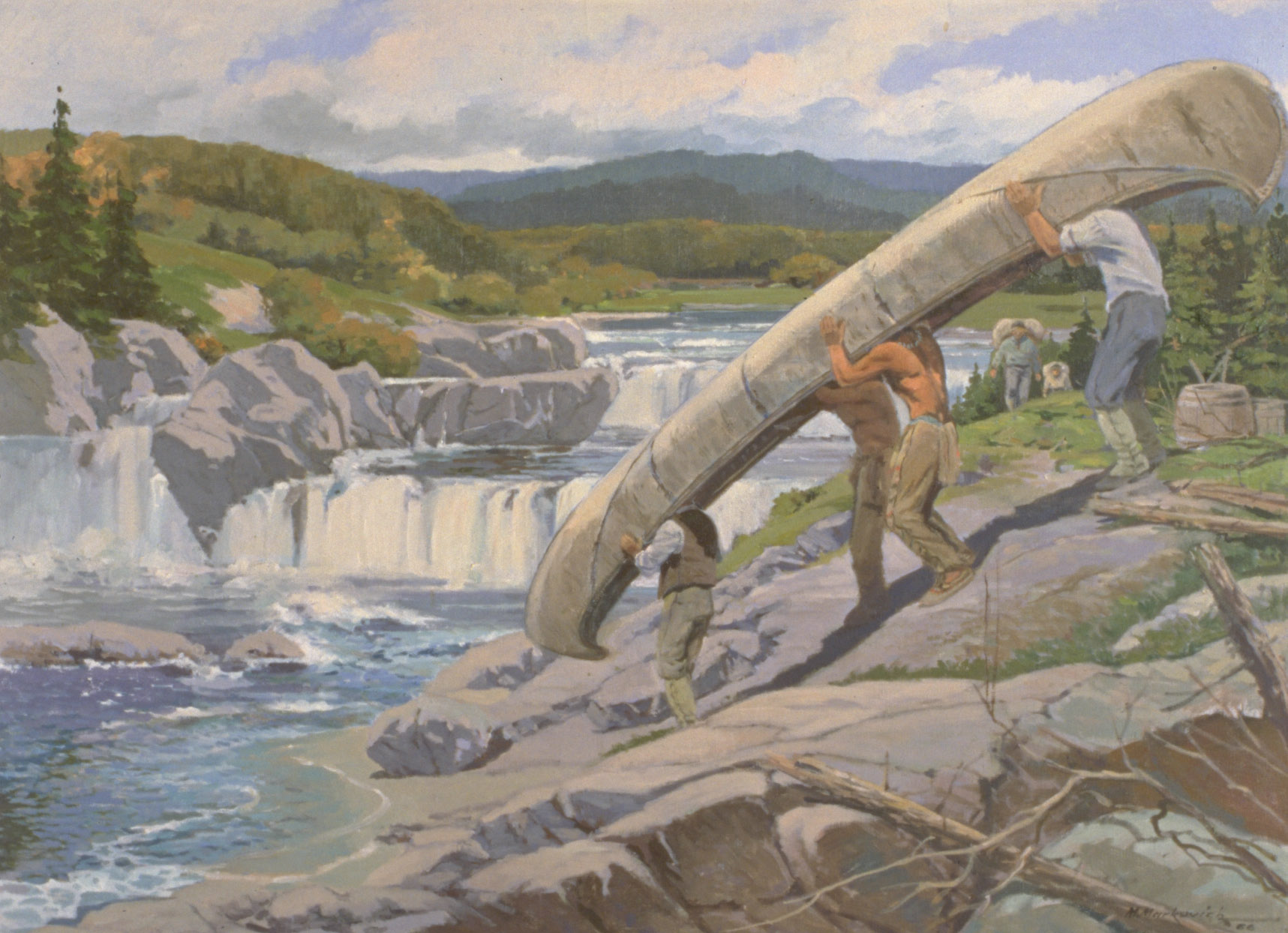
"The Portage – The Carrying Place."
© Moma Markovich.

Person walking through snowy forest.
© Moma Markovich.
For most of its history, what we now know as Ontario was a virtually impenetrable landscape of dense forest and rough terrain. First Nations, the first explorers, French and English military, fur traders, missionaries, surveyors and settlers all made the first footpaths across this province.
Up until the late 18th century the major transport routes were rivers and lakes, with the boat or canoe being the preferred mode for long-distance travel. The St. Lawrence River and Great Lakes were the early highways of Ontario. The forerunner of the modern road was the “portage”—rough trails detouring rapids or linking lakes that were vital paths for travellers using waterways. Many of the early roads followed these original portages and tracks cleared by the aboriginals. When not travelling by water, most people simply got around on foot or horse.
In 1793, soldiers and local settlers built what is believed to be the first section of roadway in Upper Canada—eight kilometres of bumpy trail between Kingston and Bath. In 1796, Yonge Street was built by the British military from Toronto up to Lake Simcoe.
Roads of this era were primitive and often only usable in mid-summer when the earth was dry and hard enough for travellers on horseback, or in winter, when the packed snow allowed sleigh travel.
1800s: Corduroy, plank and macadam roads to the golden age of railroads
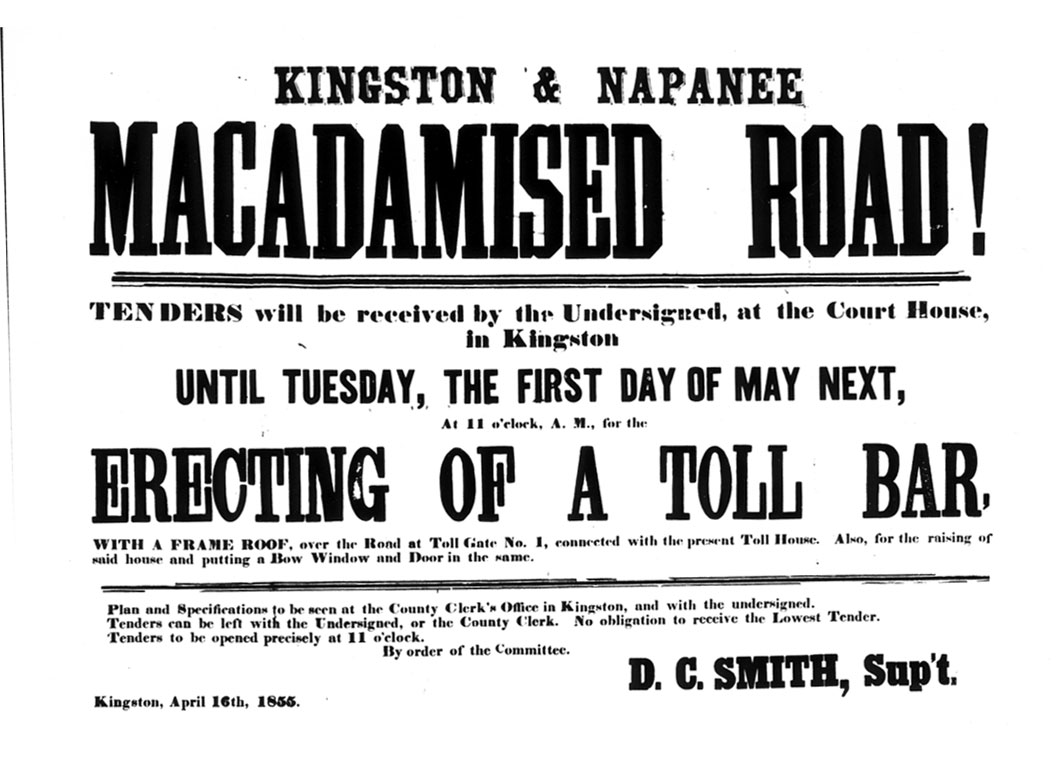
An advertisement about the Kingston and Napanee macadamised road, 1855.
Image from MTO's collection.

A couple going to Markham in a horse-drawn carriage, date unknown.
Image from MTO's collection.
By the early 1800s, the government became more involved in the funding, construction and maintenance of roads for several reasons: to open new areas for settlement, to improve postal service, to foster commerce and to facilitate the administration of government and movement of the military.
While most roads were simple dirt tracks, early methods of road improvement included the notorious “corduroy” roads—rows of cut logs— which often gave bone-rattling, wheel-destroying rides which horses shied away from for fear of breaking their legs.
Later, the more effective plank roads were introduced. They were the preferred technology by the 1850s when split or sawn timber became more readily available but only survived a couple seasons or so without proper maintenance. Later in the century macadam roads—a road surface made with small broken stones—would become the preferred technology.
Government eventually allowed municipalities and private companies to set up toll booths on turnpikes in an effort to improve the sorry state of road construction and maintenance. Often local municipalities or townships sold the rights to operate a section of road, along with the right to charge tolls to recoup costs.
During the latter half of the 1800s, Ontario roads were in a serious state of neglect and deterioration. Historians call this the “dark age of the road” where roads were being uploaded and downloaded among levels of government. Roads were opened, roads were abandoned.
But this would begin to change in the 1890s—when the first automobiles appeared.
The bicycle and automobile arrive

One of Ontario's first licence plates, 1903.
Image from MTO's collection.

Car on a bridge in Oakville, date unknown.
Image from MTO's collection.
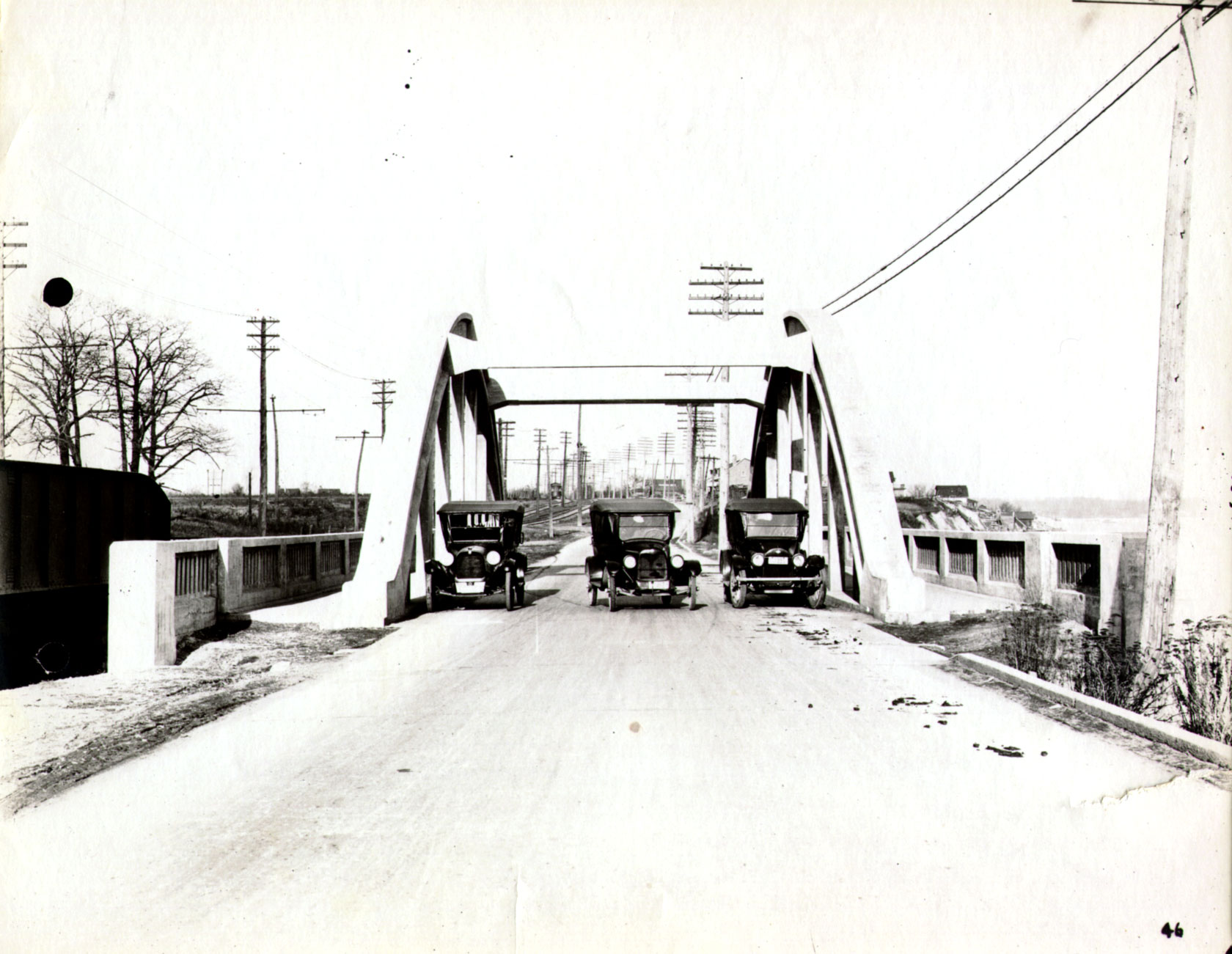
Cars on a bridge in Oakville, 1923.
Image from MTO's collection.
The bicycle’s rising popularity increased the pressure to improve roads connecting towns and villages. Day trippers, bike tourists and bike racers were an influential lot and advocated for good roads.
Automobile enthusiasts kept up that pressure. The Ontario “wheelman” lobby was led by Dr. Percy Doolittle. He later became the first president of the Canadian Automobile Association and was a major proponent for the construction of the Trans-Canada Highway. Doolittle and many other cycling enthusiasts pressed for “good roads."
In 1894, the Ontario Good Roads Association was founded and began its tradition of advocating better roads amid a growing recognition of the need for improved and safer roads for economic growth and community access. This led the provincial government to become more involved in transportation issues.
The first Provincial Instructor in Road Making was appointed in 1896 in the Department of Agriculture to promote improved road construction and maintenance. This position became the Commissioner of Public Highways in 1900 and, in 1905, was transferred to the Department of Public Works as the Deputy Minister of Public Works.
Provincial interests in roads were reflected in the 1901 legislation that provided provincial funding for local road improvements, mainly at the county level. Ontario’s first automobile arrived in 1898 and the first provincial legislation governing automobile use came into effect in 1903. It included a 15 mile-per-hour (approximately 24 km/h) speed limit and a requirement for vehicles to be registered.
Ontario’s first 198 licence plates were also issued in 1903. For several years the registration process was administered by a single clerk in the Provincial Secretary’s office. But it wasn’t until the famous Ford Model T started rolling off the assembly lines in 1908 that the automobile era was truly ushered in across North America. Ontario first issued drivers licences in 1909, but only to chauffeurs -- those who drove vehicles owned by others.
The first provincial Traffic Patrol was formed in 1907 within the Highways Branch of the Department of Public Works, although municipal police provided the bulk of road enforcement across the province.
By 1913, there were over 17,300 motor vehicles registered in Ontario, including 39 steam and 223 electric powered vehicles, and fewer than a thousand motorized delivery wagons and motor trucks. A total of 3,514 chauffeur’s licences were issued.
Even back then, traffic jams had become a constant problem on the existing Lake Shore Road between Toronto and Hamilton. Although a familiar problem in our world today, bumper-to-bumper traffic was something new to the drivers of motor cars in those days. The municipal councils of Hamilton, Burlington, Nelson, Bronte and Oakville urged the provincial government to build a “permanent” highway between Toronto and Hamilton. They argued that the municipalities could only afford to build an ordinary macadamized road—a pointless expenditure, in light of the fact such a road would hold up under heavy traffic for only one or two years. The provincial government recognized the urgency of the situation and authorized a survey on a number of Toronto-Hamilton routes, eventually landing on the Lake Shore road as the most viable.
By 1916, in response to the increasing focus on the automobile, Ontario decided that roads were a big enough priority to merit the energies of a full-fledged department.
Birth of the Department of Public Highways of Ontario
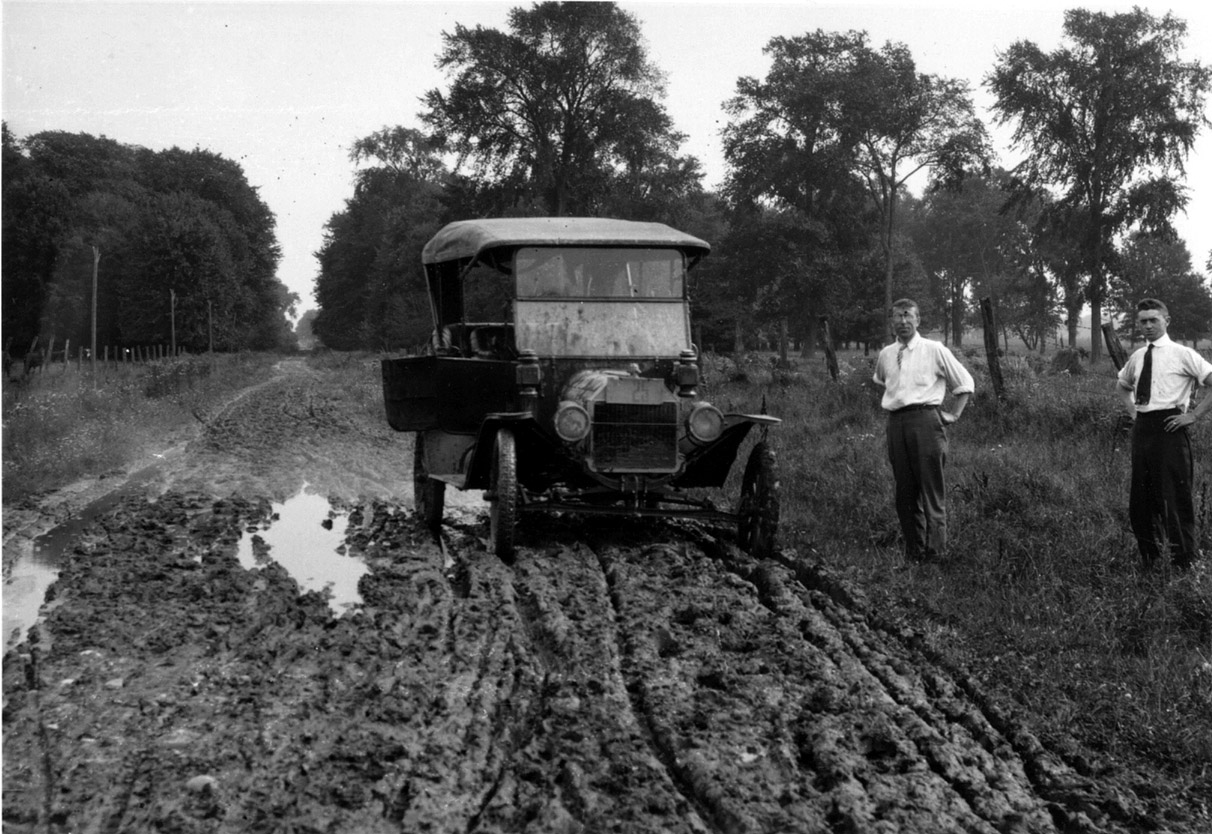
A muddy road in Middlesex County, 1915.
Image from MTO's collection.

The Toronto-Hamilton Highway, 1916.
Image from MTO's collection.
The Department of Public Highways of Ontario (DPHO), as the ministry was then called, was established on January 17th in 1916. The staff, 35 in all, included engineers, surveyors and clerical staff. There was only one problem: there weren’t any official provincial highways.
At the time, Ontario’s road system consisted of 50,000 km of gravel along which Ontario’s 54,500 registered vehicles bounced and rattled an impressive 15 miles per hour (24 km/h). These gravel roads formed a network across the province along with 40,000 km of macadamized dirt roads.
The DPHO had a vision for Ontario’s future which included connecting the whole province with network of smooth and safe paved highways. Its task was to plan, build and maintain these roads to serve the growing population of motorists.
World War I was already well under way when the Department of Public Highways was created. During the war, road construction and maintenance were neglected due to scarcity of labour, high cost of materials, high wages and a lack of railway service for the transportation of materials.
In some towns, labour was so scarce that absolutely no road maintenance could be completed. “Unnecessary labour of all kinds, and unnecessary expenditure should undoubtedly be avoided in time of war, not merely on the part of national and municipal governments, but also by the individual citizen,” wrote W.A. McLean, the department’s first deputy minister, in the 1917 annual report. However, provincial funding was provided for essential local road maintenance and for building the first all-concretel highway.
This highway, between Toronto and Hamilton, was officially opened to traffic in November 1917 and would figure prominently in the subsequent development of southern Ontario.
One division of the newly formed department was called the Motor Vehicles Branch, which was transferred from the Department of the Provincial Secretary. The original function of the Motor Vehicles Branch was the registration of vehicles, although it quickly grew to include many other responsibilities such as the licensing and examination of drivers, the regulation of the size and condition of vehicles and the compilation of driver and accident records. In 1919, the motor vehicle branch was recognized as a distinct entity and a Motor Vehicle Registrar was appointed.
1920s

First official Road Map of Ontario, 1923. "Ontario Provincial Highways and other Main Travelled Roads - Map of Part of the Province of Ontario - 1923"
(Archives of Ontario, RG 14-100-0-0-1, I0050469).
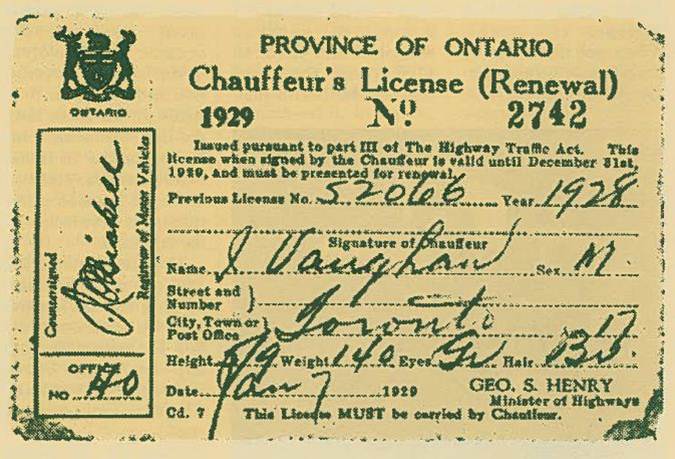
An Ontario driver's licence, 1929.
Image from Inside Routes – Special Anniversary Edition.
The roaring 20s were characterized by a mid-decade recession followed by a boom and then the famous market crash of 1929. It was also marked by the noise of automobiles that were rapidly filling the roads. The number of vehicles on Ontario roads increased from 172,000 to 562,000 during this decade. The DPHO was carrying out its strategy for southern Ontario’s provincial highway system and was working closely with municipalities to improve local road networks.
The 1920s was a decade of firsts: the department introduced snow removal, an official road map, driver licensing, a trucking act, an all-weather road to the north, and a gasoline tax. By 1927, with the number of automobiles increasing steadily, it was decided that everyone driving a motor vehicle in Ontario would have to obtain an operator’s licence. (Since 1909, it was only “chauffeurs” who required a licence; prior to that, all you needed was access to a car.)
Other Highlights:
- Formal road systems were established and organized, resulting in a total of 9,725 miles of county roads and 1,825 miles of provincial highways.
- The first provincial Highway Traffic Act is passed, which consolidates a number of earlier traffic laws and regulations. The speed limit for highways becomes 25 mph (40 km/h).
- With money tight and federal funding running out, the gasoline tax is introduced at three cents a gallon.
- Provincial highways are numbered and crossroads and curves signed.
- First traffic lights are introduced in Toronto and Hamilton.
- In 1926, the last toll road in Ontario is removed.
- In 1928, commercial vehicles are officially regulated by the Province.
- Beginner permits also become available, which are only valid when the operator is accompanied by a fully licenced driver.
- Gaps in important northern roads are filled, most notably on the Cochrane-Hearst Road between Smooth Rock Falls and Cochrane and the road between Espanola and Little Current.
1930s
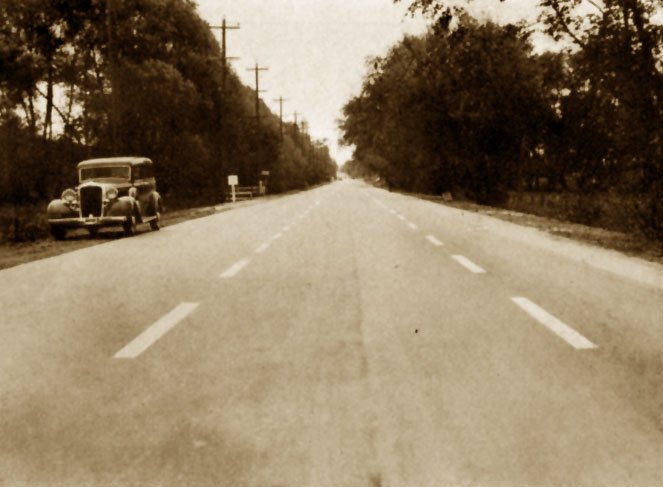
Centre lines on Highway 11, 1932.
Image from MTO's collection.
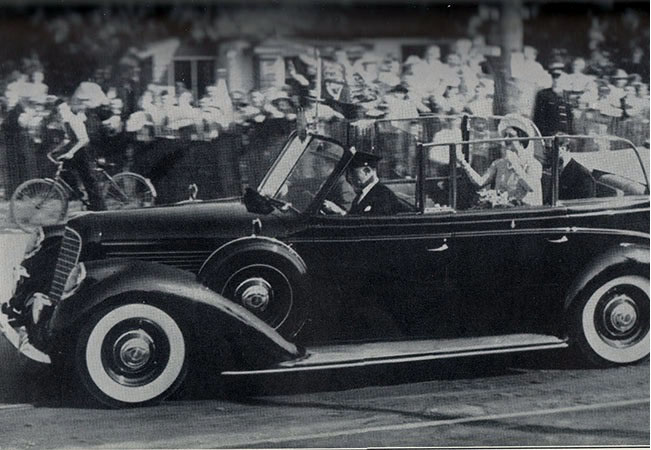
King George VI and Queen Elizabeth at the official Queen Elizabeth Way dedication ceremony in St. Catharines, 1939.
Image from MTO's collection.
When the devastating effects of the Great Depression hit Ontario, the department became an economic anchor in a stormy sea. Many hundreds of highway and road projects all over Ontario focused on “unemployment relief”. One of the most notable of these projects—called the “Middle Road” because of its location between the Lakeshore (Highway 2) and Dundas Street (Highway 5)—would later became known as the Queen Elizabeth Way.
However, not all jobs were saved. Department staff was cut by 25 per cent, including highly trained engineers and technicians with years of experience. Despite these challenges, important progress was made.
Traffic enforcement duties were transferred from the department to the Ontario Provincial Police. And a remarkable innovation: the broken white line to delineate the centre of highways was introduced in Ontario by J.D. Millar, a DPHO engineer who would alter become deputy minister. This was the first road marking of its kind in Canada.
The decade culminated with one of its biggest undertakings: the dedication of the Queen Elizabeth Way (QEW) in June 1939, just a few months before the start of WWII. On hand for the ceremony were King George VI and Queen Elizabeth, who drove in a motorcade in a Buick convertible as over 20,000 people watched them pass along the St. Catharines portion of the road.
Other Highlights:
- In 1931, the department’s name officially changes to Department of Highways.
- By 1937, DHO becomes responsible for northern Ontario roads when it is merged with the department of Northern Development, increasing its road mileage from 3,743 to 7,242 miles (6,024 to 11,655 km) and adding 8,145 miles (13,108 km) of county roads.
- Nipigon River Bridge opens on September 24, 1937, a crossing that even today remains the only paved route linking eastern and western Canada.
- The QEW becomes the first inter-city divided highway in Canada. It also features the first cloverleaf interchange in Canada (at Hwy. 10).
1940s

Windshield stamp for registered vehicles, 1944.
Image from MTO's collection.
When the Second World War started in September 1939, hundreds of DHO staffers joined the armed forces. By 1942, road building came to a virtual halt. Priority was given to providing access to munition plants, military camps and airfields. Both materials and labour were in short supply—at one point windshield decals had to replace licence plates due to the metal shortage. Things slowly got back to normal after the war. Maintenance activities were given high priority to bring existing highways to pre-war standards.
Other Highlights:
- Preliminary work on what is now Highway 400 begins.
- The section of what is now Highway 401 from Highland creek to Oshawa is completed.
- In 1943, completion of the 157-mile stretch between Hearst and Geraldton provides a cross-Canada highway route.
- In 1949, the first meeting occurs with the federal government on funding for construction of the Trans-Canada Highway.
- DHO’s Tom Mahoney develops a system to keep track of, and determine causes of, road accidents. This would prove to be a vital factor in improving road safety in the years to come.
1950s
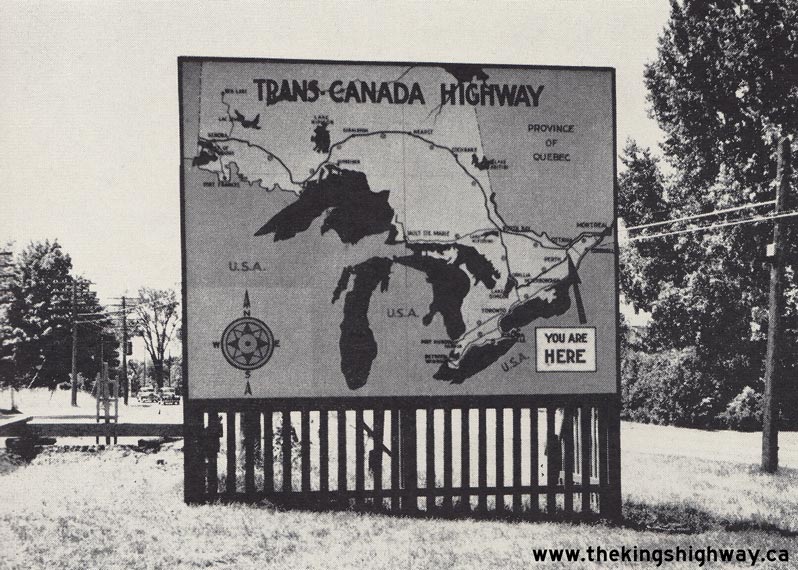
Trans-Canada Highway sign near Ottawa, 1950.
Image from MTO's collection.

Side view of the Burlington Bay James N. Allan Skyway, 1958.
Image from MTO's collection.
The economy was strong and there was a new spirit of optimism. The population of Ontario was increasing by 10,000 per month. And the DHO was hard-pressed to keep up with the demand for new and better highways.
The Trans-Canada Highway Agreement of 1950 set the stage for the construction of a sea-to-sea road network. The five-year plan provided $30 million a year in new construction on the King’s Highways.
Unfortunately, the frenzy of construction led to a dark period in the department’s history. In 1953, internal government audits discovered that several DHO employees and private contracting firms had defrauded the federal and provincial governments of about $7 million on some road construction projects in Northern Ontario. It became a major scandal of the day. Three companies were eventually fined and made repayments, and a federal Public Works inspector and a DHO engineer were given short jail terms and fines.
In 1955, a Select Committee of the Legislative Assembly concluded that the roads involved were well-built but that better processes for managing road construction projects were necessary. In the end, however, the department emerged from its darkest hour as a more aware and responsible entity. In the following years the department developed a series of checks and balances to ensure an open, transparent and fair system with rigorous ministry controls and oversight.
In 1958 the department solved the long, traffic jams at the QEW’s two-lane lift bridge over the ship canal on the Burlington beach strip by opening the Burlington Bay Skyway, which provided a four-lane controlled access highway. At two and a half kilometres in length and resting on 76 piers, it was the longest bridge structure undertaken in Canada at the time. When the Skyway was opened, there were two million registered vehicles in Ontario.
Other Highlights:
- Plans for a new east-west divided highway from Windsor to the Quebec boundary are announced (Highway 401).
- In 1952, highway numbering series 400 is established to designate freeways, starting with Highways 400 and 401 and 402.
- Highway 400 from Toronto to Barrie opens, with its slight roller-coaster contour and almost imperceptible curves designed to prevent highway hypnosis.
- Atikokan highway opens for traffic, providing access to mining, lumbering and tourist areas.
- Highway 69 from French River to Sudbury opens.
- Highway 27 is widened to a dual-lane, controlled access highway from the 401 to the QEW.
- In 1957, a new Department of Transportation (DOT) is created, incorporating driver, vehicle and carrier enforcement functions previously conducted by DHO. (It would remain a separate department until its merger with DHO in 1971).
- In 1959, a major innovation in road safety emerges with the introduction of the demerit point system for driving offences.
1960s
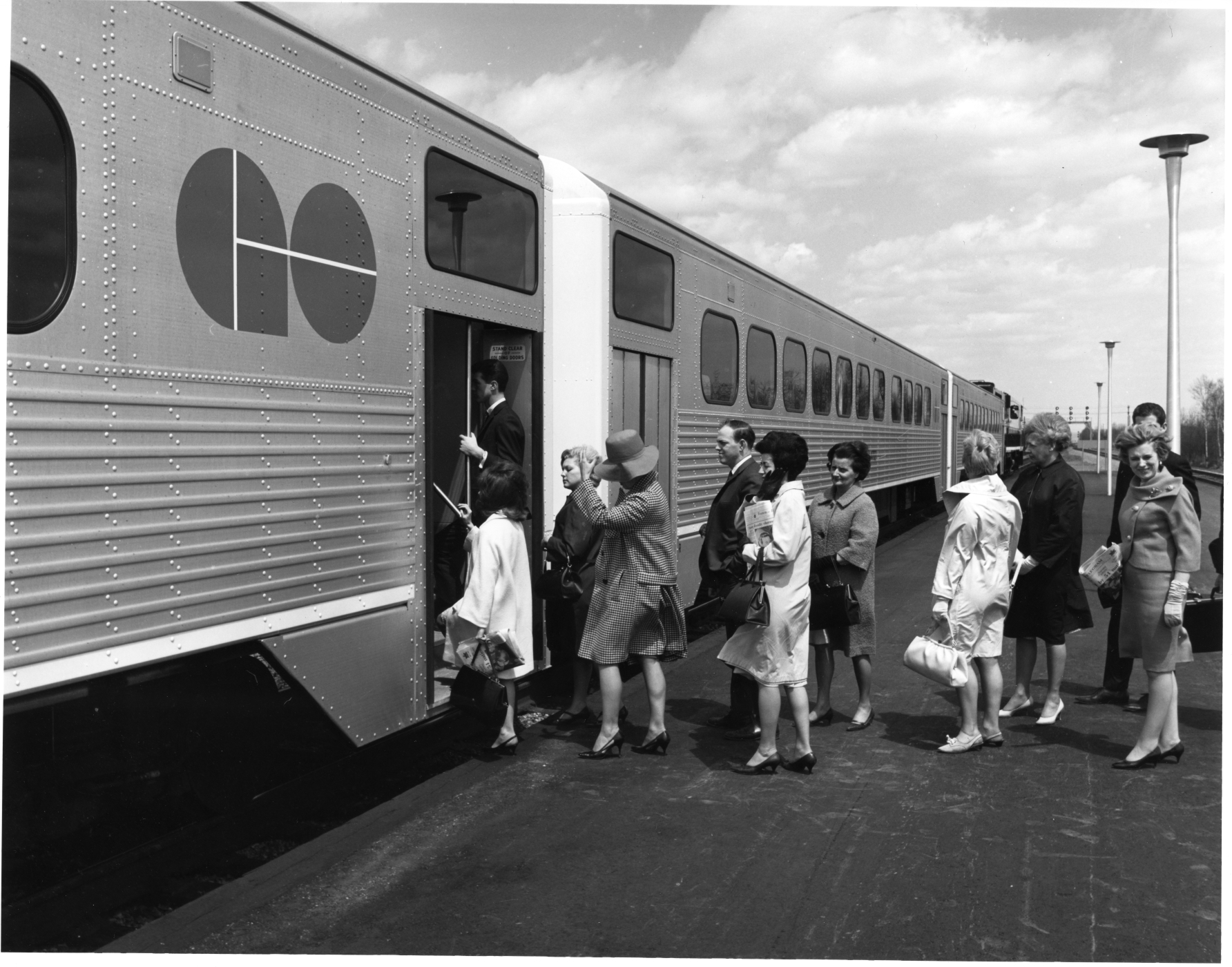
Passengers participate in a GO Transit train test run, 1967.
Image from MTO's collection.
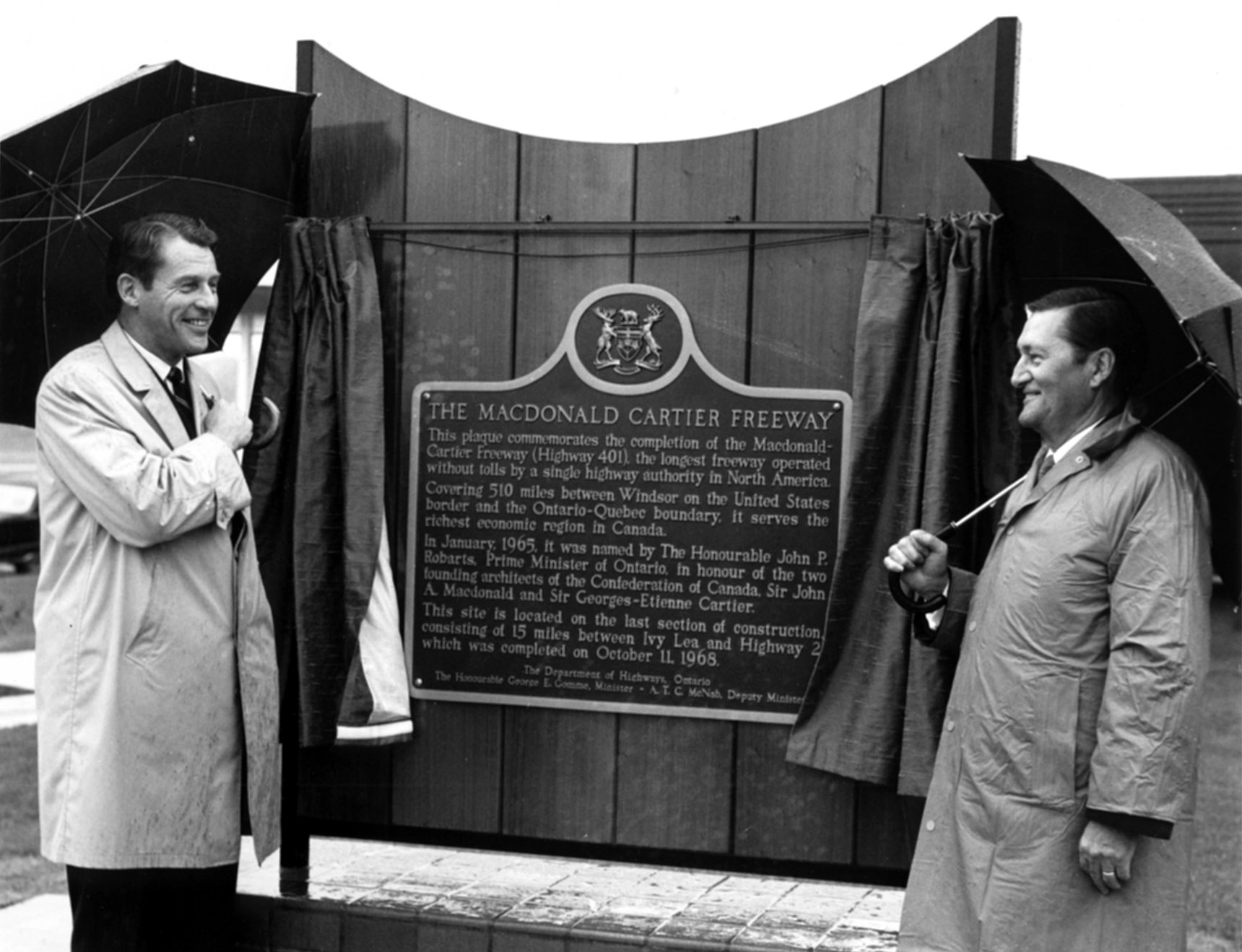
Officials standing next to a plaque that commemorates the completion of Highway 401 (Macdonald-Cartier Freeway), 1968-1969.
Image from MTO's collection.
These were the golden years of highway and road transportation in Ontario. Tourist traffic was now rolling on the Trans-Canada Highway’s Lake Superior route. Major highways like the 401 were fully completed. GO Transit was launched. And the very first seeds were planted for the development of northern remote airports.
Although the focus remained on highways and roads, department responsibilities for other transportation modes were also growing. In response to the post-war suburban growth and growing vehicle demand on the QEW, an experimental GO Train service was launched along the Lakeshore between Oakville and Toronto. The first trip was taken on May 23, 1967 at 5:50 a.m., when GO Transit began operating trains between Oakville and Dunbarton (Pickering) with rush hour service between Hamilton and Pickering. By today’s standards, the system was quite small. It had 14 stations on 94 km of track.
GO Transit was an immediate success. On the first day, the system carried 8,000 riders. Within eight months, it was averaging 15,000 customers a day. In the first year, 2.5 million people used the service. GO Transit bus service would be added a few years later.
In addition to transit, in 1968, Ontario introduced the Airport Act, which included a policy of establishing airports in remote communities to serve them by air rather than by all-weather roads. This would change the way of life for the residents of communities north of the 50th parallel.
Other Highlights:
- A 60-mile extension on Highway 101 from Foleyet to Chapleau is completed.
- Sault-Ste. Marie and Queenston-Lewiston International Bridges opens.
- In 1963, the first eight permanent services centres open on Highway 401 (now known as OnRoute).
- Garden City Skyway opens at St. Catharines.
- New International Bridge at Pigeon River opens, providing a link to Grand Portage, Minnesota.
- In 1965, Highway 401 officially named the Macdonald-Cartier Freeway.
- An 85-mile stretch on Highway 11 between Atikokan and Fort Frances opens.
- In 1966, the Ottawa Queensway is completed.
- A 45-mile stretch opens on Highway 807 from Smooth Rock Falls to Fraserdale.
- An 80-mile stretch opens on Highway 101 from Wawa to Highway 129.
1970s

Seatbelt safety demonstration, 1974.
(Archives of Ontario, RG 14-151-21-55, I0051675).
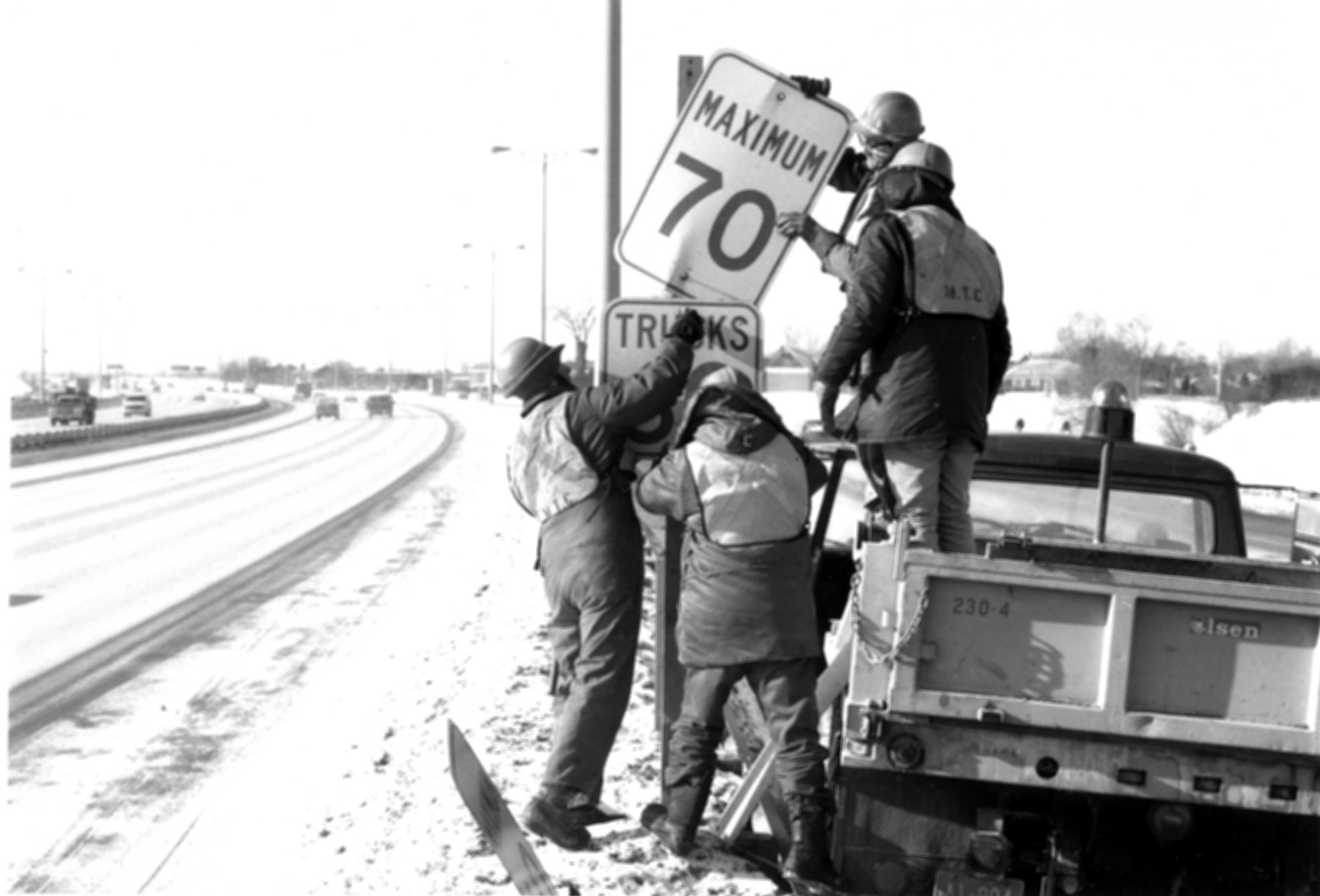
Workers removing speed signs (replaced with reduced speeds) on Highway 401, 1976.
Image from MTO's collection.
The seventies brought a new outlook as the Department of Highways amalgamated with the Department of Transportation. In 1971, with the added responsibility for communications, the Department of Transportation and Communications was born. One year later, as part of a government-wide change of Departments to Ministries it would be called the Ministry of Transportation and Communications (MTC).
The new ministry was committed to achieving a better balance between public transit, commuter services and motor vehicle traffic, and to integrating road, rail, air and marine services. Also, the ministry began work to build its "highway in the sky" by building remote airports in northern Ontario. Ministry staff was sent to the communities to lead construction sites; arrange for equipment and material delivery; and hire local residents to build the airports and clear the land, a process that would take many months.
Since most remote airports were built near or on reserves, aboriginal communities participated in all aspects of airport development and operation, which included consultation from Band Councils regarding location. The airports were a walkable distance from communities as vehicles in these parts were uncommon at the time. By 1971 DHO initiated “norOntario” airline, which provided commuter air service in northeastern Ontario.
This decade was also a major turning point for road safety. In 1976 seat belt laws came into effect. By the year’s end, traffic related deaths dropped to their lowest level in more than a decade.
Other Highlights:
- In 1970, the last section of the Lakehead (Thunder Bay) Expressway opens, as did Highway 144 from Sudbury to Timmins.
- GO Transit’s bus service started in 1970 as an extension to the Lakeshore Line’s service. Later additions to the bus network occur between Toronto and Guelph, among other routes.
- Ontario bans studded tires.
- The first “Own Choice” plate is made available for $25.
- St. Joseph Island Bridge near Sault Ste. Marie opens.
- The ministry pilots the first dial-a-bus service in Pickering 1970-1973.
- Tolls on the Garden City and Burlington Bay Skyways, which were in place since they opened, are removed in December 1973.
- In 1974, new GO Train service becomes available between Georgetown and Toronto. Also in that year, the Toronto Area Transit Operating Authority (TATOA) is established as a Crown agency to develop transit systems across regional boundaries. This was the forerunner to Metrolinx.
- Ottawa to Quebec stretch of Highway 417 is completed.
- The ministry lowers speed limits for Ontario highways from 70 to 60 miles per hour (112 to 96 km/h), and from 60 and 55 miles per hour to 50 (96 and 88 km/h to 80 km/h). This was largely an attempt to conserve fuel in the face of international fuel shortages.
- In 1977, highways and the Ontario road map start using the metric system.
- Concrete median barriers are introduced.
- A new driver licence classification system introduces 10 classes of licences that define which types of vehicles can be driven under each class.
- New route of Highway 40 opens from Sarnia to Wallaceburg.
- By the end of the decade MTC implements long-distance phone, radio and TV service to 20 remote communities in northwestern Ontario.
- A new school bus inspection program is launched.
- Highway 409 is opened, connecting Highways 401 and 427 to the Toronto airport.
- First commuter parking lots open.
1980s
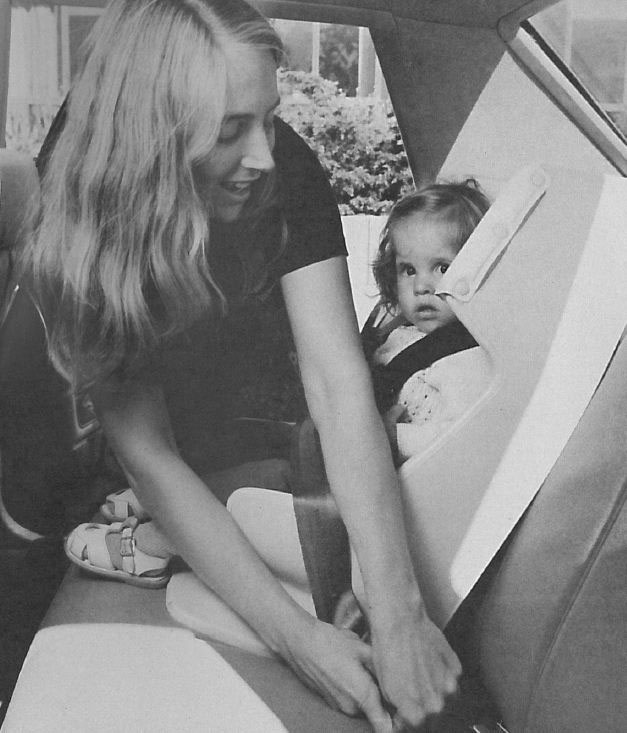
Front cover of the Ministry of Transportation and Communications newsletter, 1982.
© Andy Christopher.

Aerial view of Fort Hope and the Fort Hope Airport in Northern Ontario, 1986.
Image from MTO's collection.
The Ministry of Transportation and Communications (MTC) continued to expand its services, including helping to provide specialized transit for disabled persons, and an increasing focus on other transportation modes.
The expansion of the highway system was slowing, but improvements to the existing system continued. In 1987, there was a ground-breaking for the construction of the first segment of Highway 407 (from Highway 427 to Dufferin Street) Highway 401 and other freeways were also widened during the 1980s.
A new Truck Transportation Act was passed into law and mandatory use of child safety seats was also introduced. The ministry also introduced a probationary status for all new drivers. And in 1986, a new photo-driver licence system came into effect.
The 1980s also saw continuous growth of air services. And by the end of the decade, highways were carrying 70 per cent of all goods moved through the province and there were more than 8.5 million vehicles on Ontario roads.
Other Highlights:
- Four-lane Highway 17 section from Lively to Whitefish opens.
- In 1981, during the International Year of the Disabled Person, the ministry begins providing a 75 per cent subsidy to transit service providers to improve accessibility for disabled persons.
- St. Thomas Expressway opens.
- Highway 403 opens between 401and the QEW in Mississauga.
- Highway 33 in Prince Edward County is dedicated and named the Loyalist Parkway by Queen Elizabeth II.
- In 1982, GO Transit initiates the Advanced Light Rapid Transit initiative, GO ALRT, resulting in the development of new LRT technology, the construction of the Scarborough Rapid Transit line and the marketing of the technology to other jurisdictions. The initiative is cancelled in 1985.
- Special licence plates are now available for persons with disabilities and “Own Choice” plates with more options became available for $100.
- In 1984, the ministry published the Ontario Intercity Guide to Public Transportation, the first of its kind in Canada.
- The Peterborough Parkway opens.
- Final section of Highway 406 opened between St. Catharines and the QEW.
- In 1985, the new Burlington Bay Skyway opens.
- The ministry leads the construction and operation of Ontario’s pavilion at the transportation-themed Expo ’86 in Vancouver.
- In 1987, the ministry becomes the Ministry of Transportation (MTO). The former communications division is transferred to the Ministry of Culture and Communications.
- Highway 404 completed to Davis Drive in Newmarket in 1989.
1990s
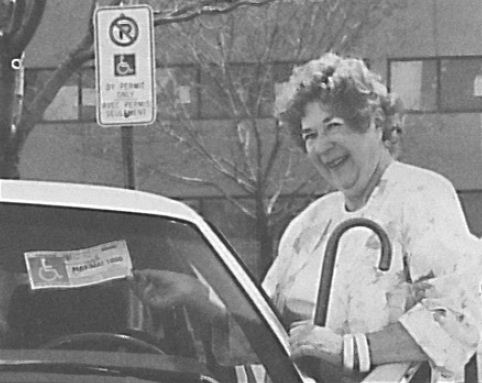
Driver uses an accessible parking permit, date unknown.
© Rick Radell.

Construction of the Highway 416 and Highway 417 interchange, 1996.
Image from MTO's collection.
The 1990s was a period of drastic change for the ministry. The first half of the decade was focused on pursuing major transportation planning strategies to support the province’s economic development. The latter part of the decade saw significant changes to the ministry’s highway and transit responsibilities. The Province downloaded control of GO Transit and a number of provincial highways to the municipalities, and wound down a number of municipal road and transit subsidy programs.
Also, during this decade the ministry was downsized cutting staff by half. This sweeping transformation resulted in MTO shifting its role into more of a manager of the highway system, with the outsourcing of construction administration and maintenance activities and driver examiner functions.
Other Highlights:
- In 1991, the Highway 401 COMPASS Freeway Traffic Management System officially opens, providing important travel information about construction conditions and commuting, and helping to manage congestion through improved incident management.
- MTO implements first tall wall concrete barriers for freeways.
- Major 400-series highway construction continues with expansion or extension of several highways.
- Highway 416, opens from Highway 401 to Highway 417.
- A new two lane Highway 17 bypass north of Kenora opens.
- In 1993, Ontario requires municipalities to provide full accessibility transit plans. All new transit vehicles leased or purchased after July 1, 1993 are required to be low floor and/or equipped with Easier Access features.
- In 1994, Ontario becomes the first jurisdiction in Canada to implement a Graduated Licensing System to novice drivers.
- In 1995, shoulder rumble strips are added to rural freeways.
- Senior driver renewal program is introduced to drivers aged 80 years and over.
- Highway 407 opens, becoming the world’s first all-electronic, open-access toll highway.
2000s
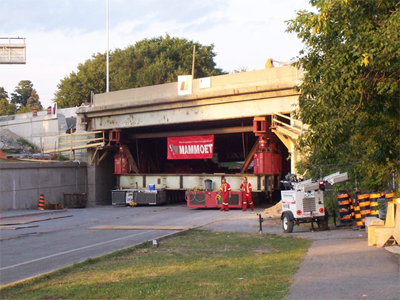
First rapid bridge replacement on Island Park Bridge, 2006.
Image from MTO's collection.
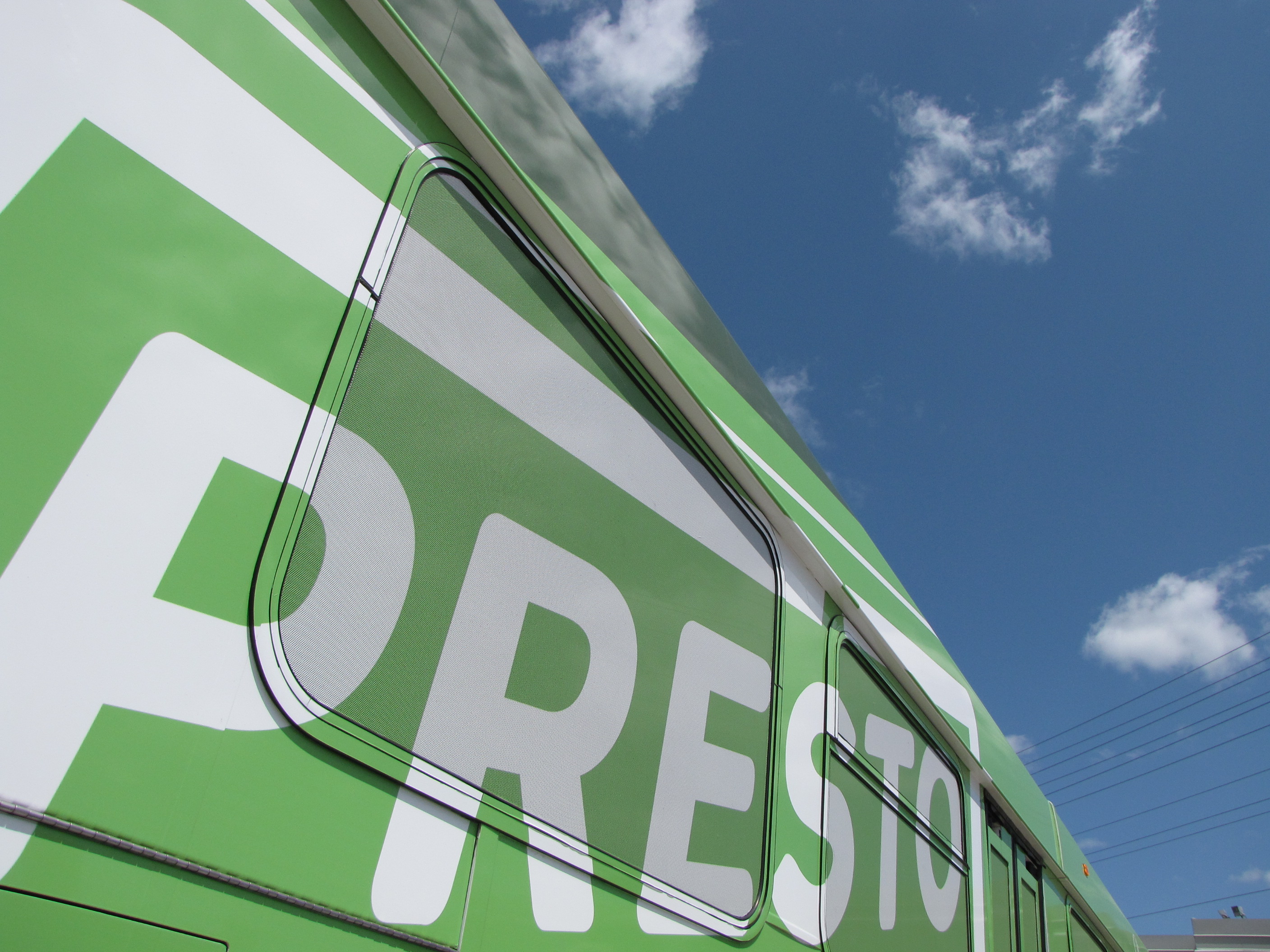
Presto logo on the side of a bus, date unknown.
Image from MTO's collection.
During this decade, the ministry re-engaged in some of the areas from which the Province pulled in the 1990s. It moved toward new relationships with municipal and federal governments for a transit system and infrastructure planning, funding and services. Since 2003, this included sharing a portion of provincial gasoline tax revenues for municipal transit funding and assuming provincial control of GO Transit. It also meant coordinating transit vehicle purchases and restructuring Metrolinx to operate GO Transit and provide longer-term transportation planning directions for the Greater Toronto and Hamilton Area.
Also during this decade, MTO made great strides with road safety, ranking every year as either first or second for safest roads in North America.
Other Highlights:
- In 2001, ministry launches Ignition Interlock Program, which requires convicted drunk drivers to blow into an in-car alcohol breath screening device before their vehicle will start.
- Ontario, Canada and Windsor announced the “Let’s Get Windsor-Essex Moving” strategy, which leads to the construction of the Rt. Hon. Herb Gray Parkway.
- The ministry releases the first Northern Highways Program and Southern Highways Program.
- Government announces that Highway 69 would be four-laned from Parry Sound to Sudbury.
- In 2005, booster seats become mandatory for small children.
- Province's first sections of HOV lanes open on Highway 403 and 404 in 2005.
- In 2006, the “one person, one seatbelt” law comes into effect, requiring every person in a motor vehicle to wear a seat belt or be properly secured in a child car seat or booster seat.
- In 2006, Province creates the Greater Toronto Transportation Authority, whose name changed shortly after to Metrolinx, to play a critical role in planning and delivering a seamless, integrated transit network for the GTA allowing people to use public transit to travel easily.
- In 2007, rapid bridge replacement technology is first used in Ontario on the Island Park Bridge in Ottawa.
- Highway 17 expansion at Sault Ste. Marie completed.
- In 2007, street racing legislation comes into effect.
- MTO launches Presto, a new electronic fare card that allows riders to transfer seamlessly across multiple transit systems. It is piloted in 2007 and full implementation begins in 2009.
- In 2008, with support from MTO, Metrolinx announces The Big Move, a long-term vision for transit in the Greater Toronto Hamilton region.
- In 2009, speed limiters for large trucks come into effect.
- Province makes it illegal to use hand-held devices while driving.
- The first provincial roundabout opens in 2009 on Highway 33 near Picton.
2010s
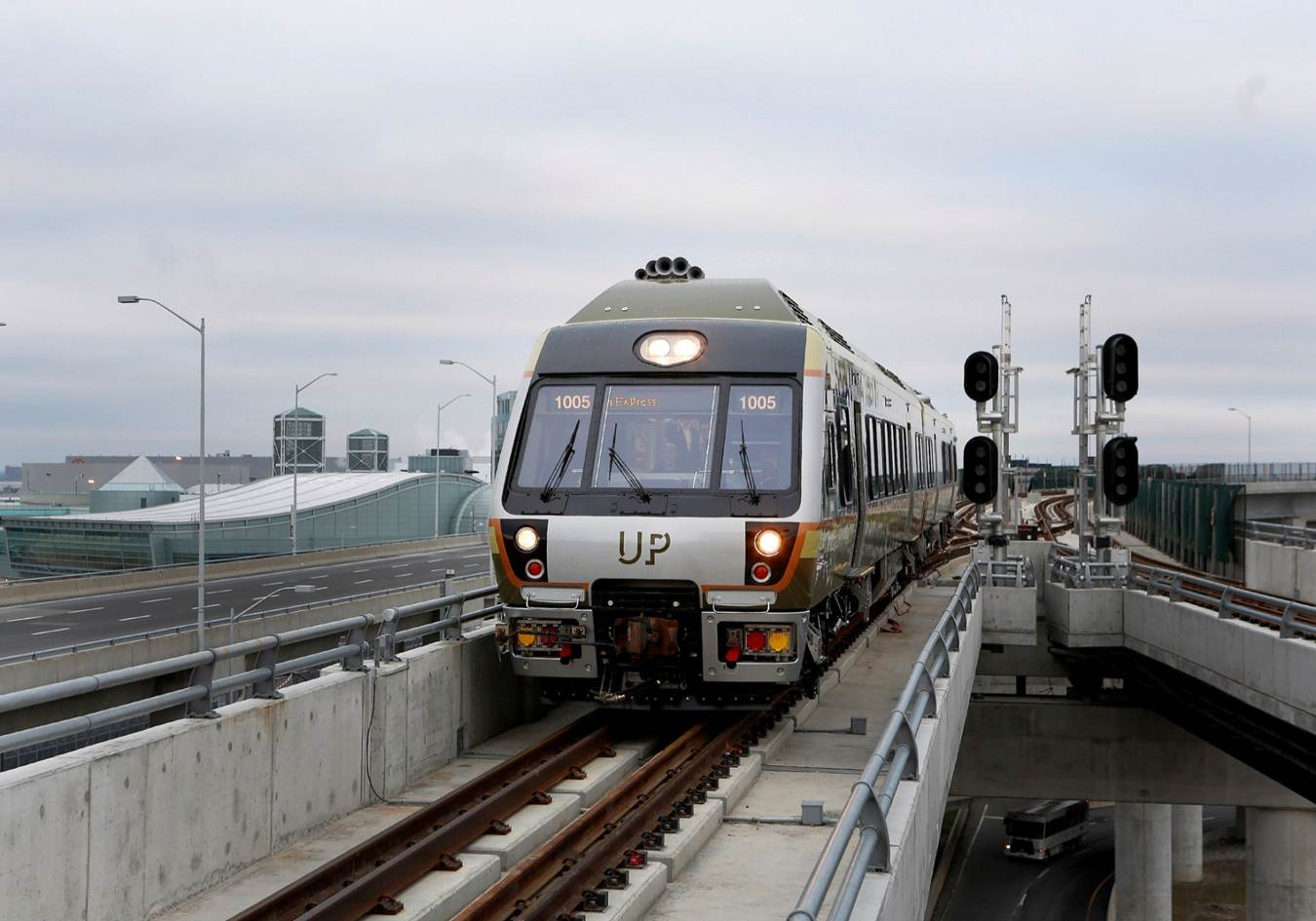
The Union Pearson Express, 2014.
© Queen's Printer for Ontario, 2014.
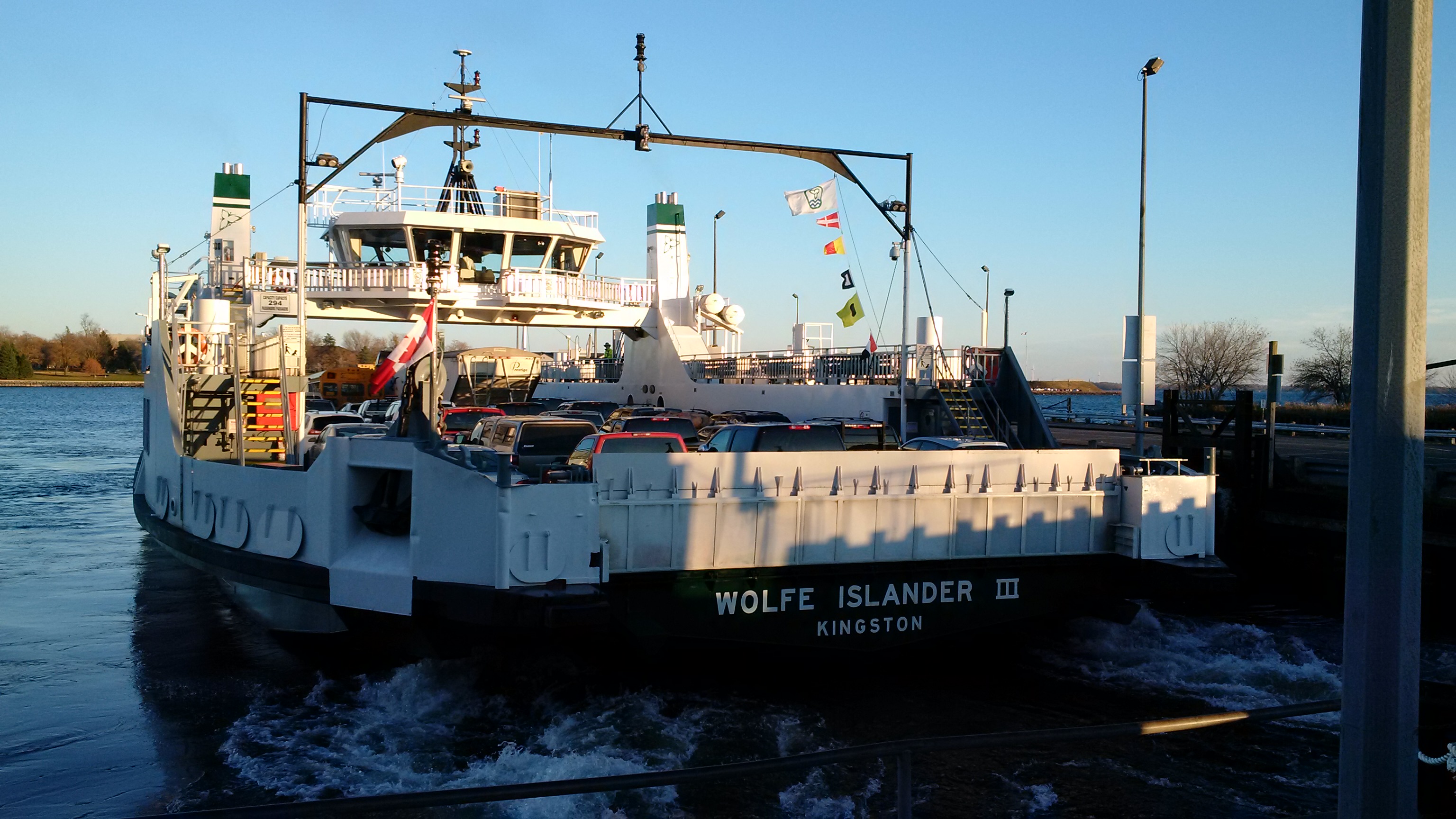
The Wolfe Islander III, 2015.
© Kome Abel.
This decade has seen historic commitments to build better transit and transportation infrastructure. The Moving Ontario Forward plan, announced in 2014 and expanded in the 2015 budget, will make nearly $31.5-billion available over ten years for transit and transportation infrastructure. Of this, up to $16-billion will be available for investment into the GTHA, and nearly $15 billion will be available for investment in the rest of the province. MTO’s goal is to make transit and transportation investments that promote economic productivity, enhance quality of life and improve the natural environment —including reducing greenhouse gases.
Other Highlights:
- The ministry announces an electric vehicle incentive for buyers.
- MTO releases its Sustainability inSight report in 2013, a framework to integrate sustainability into all the ministry's programs, policies, and internal operations.
- The ministry continues to use rapid bridge replacement to minimize traffic disruptions. Highlights include the 2012 replacement of the Highway 401 off-ramp bridge near Yorkdale Shopping Centre in Toronto, replaced in just 53 hours. And in 2013, Ottawa’s Carling Avenue eastbound bridge in Ottawa is replaced in just 15.5 hours.
- In 2012, Highway 11 four-laning is completed between Huntsville and North Bay.
- MTO wins Environmental Commissioner of Ontario’s 2011 Recognition Award for using environmentally-friendly bioretention cells and rubber modified asphalt. This is MTO’s third ECO award since 2001.
- In 2013, MTO releases a 20-year vision to support cycling in Ontario.
- Electric vehicle charging is made available at GO stations.
- A 13-kilometre extension on Highway 404 from Green Lane to Ravenshoe Road.
- Expansion of Highway 11 from Huntsville to North Bay completed in 2012.
- In 2015, 30 km of new four lane divided Highway 11/17 in the Thunder Bay to Nipigon corridor is completed.
- Highway 69 (400) expansion continues with new sections opened.
- In 2015, Union Pearson Express opens, providing rail service from Toronto Pearson Airport to Union Station in downtown Toronto.
- MTO successfully supports the Pan and Parapan Am Games by keeping traffic moving in the GTHA during the largest sporting event ever held in Canada.
- New road safety rules come into effect as various pieces of road safety legislation become law. For example, Bill 31—Making Ontario's Roads Safer Act implements tougher penalties for distracted driving, new rules to protect cyclists and measures to ensure the safety of tow truck drivers and children riding school buses.
- MTO launches a new pilot to allow for the testing of automated vehicles on Ontario roads.
- Province appoints special advisor for high speed rail to assist Ontario in bringing high-speed rail to the Windsor, London, Kitchener-Waterloo, and Toronto corridor.
- Highway 401 section of the New Rt. Hon. Herb Gray Parkway is completed.
- On January 17, 2016 MTO celebrates its 100th anniversary. As part of its activities to recognize its heritage and build for the future, the ministry develops new strategic directions and objectives for the ministry for the coming years.
Ministry of Transportation Timeline
1916-1931: Department of Public Highways of Ontario (DPHO)
1931-1971: Department of Highways of Ontario (DHO)
1957-1971: Department of Transportation (DOT)*
1971-1972: Department of Transportation and Communications (DTC)
1972-1987: Ministry of Transportation and Communications (MTC)
1987- : Ministry of Transportation of Ontario (MTO)
*Note: The DHO was formed in 1931 while the DOT was formed in 1957. Both operated as separate departments until 1971, when they were merged into the Department of Transportation and Communications.
Ministers of Transportation Timeline
DEPARTMENT OF PUBLIC HIGHWAYS OF ONTARIO (DPHO)
(1916 - 1919) Hon. Findlay G. MacDiarmid
(1919 - 1923) Hon. Frank C. Biggs
(1923 - 1931) Hon. George S. Henry
DEPARTMENT OF HIGHWAYS OF ONTARIO (DHO) AND DEPARTMENT OF TRANSPORTATION (DOT)
Note: The DHO was formed in 1931 while the DOT was formed in 1957. Both operated as separate departments until 1971, when they were merged into the Department of Transportation and Communications.
(1931 - 1934) Hon. Leopold Macaulay (DHO)
(1934 - 1943) Hon. Thomas B. McQuesten (DHO)
(1943 - 1955) Hon. George H. Doucett (DHO)
(1955 - 1958) Hon. James N. Allan (DHO and DOT)
(1958) Hon. Matthew B. Dymond (DOT)
(1958 - 1960) Hon. John Yaremko (DOT)
(1958 - 1961) Hon. Frederick M. Cass (DHO)
(1960 - 1962) Hon. Henry L. Rowntree (DOT)
(1961 - 1962) Hon. William A. Goodfellow (DHO)
(1962 - 1963) Hon. James A.C. Auld (DOT)
(1962 - 1966) Hon. Charles S. MacNaughton (DHO)
(1963 - 1971) Hon. Wesley I. Haskett (DOT)
(1966 - 1971) Hon. George E. Gomme (DHO)
(1971) Hon. Charles S. MacNaughton (DOT)
DEPARTMENT OF TRANSPORTATION AND COMMUNICATIONS (DTC)
(1971 - 1972) Hon. Charles S. MacNaughton
MINISTRY OF TRANSPORTATION AND COMMUNICATIONS (MTC)
(1972 - 1974) Hon. Gordon R. Carton
(1974 - 1975) Hon. John R. Rhodes
(1975 - 1985) Hon. James W. Snow
(1985) Hon. George R. McCague
(1985 - 1987) Hon. Edward A. Fulton
MINISTRY OF TRANSPORTATION OF ONTARIO (MTO)
(1987 - 1989) Hon. Edward A. Fulton
(1989 - 1990) Hon. William M. Wrye
(1990 - 1991) Hon. Edward T. Philip
(1991 - 1994) Hon. Gilles Pouliot
(1994 - 1995) Hon. Michael L. Farnan
(1995 - 1997) Hon. Al Palladini
(1997 - 1999) Hon. Tony Clement
(1999 - 2001) Hon. David Turnbull
(2001 - 2002) Hon. Brad Clark
(2002 - 2003) Hon. Norman W. Sterling
(2003) Hon. Frank Klees
(2003 - 2006) Hon. Harinder S. Takhar
(2006 - 2007) Hon. Donna Cansfield
(2007 - 2010) Hon. James J. Bradley
(2010 - 2011) Hon. Kathleen O. Wynne
(2011 - 2013) Hon. Robert Chiarelli
(2013 - 2014) Hon. Glen R. Murray
(2014 - 2018) Hon. Steven Del Duca
(2018 - ) Hon. Kathryn McGarry
Deputy Ministers Timeline
DEPARTMENT OF PUBLIC HIGHWAYS OF ONTARIO (DPHO)
(1916 - 1926) William A. McLean
(1926 - 1929) Samuel Squire
(1929 - 1931) Robert M. Smith
DEPARTMENT OF HIGHWAYS OF ONTARIO (DHO) AND DEPARTMENT OF TRANSPORTATION (DOT)
Note: The DHO formed in 1931 while the DOT formed in 1957, both operating until 1971 with separate DMs.
(1931 - 1943) Robert M. Smith (DHO)
(1943 - 1954) John D. Millar (DHO)
(1954 - 1957) Melbourne A. Elson (DHO)
(1957 - 1960) D.J. Collins (DOT)
(1957 - 1962) William J. Fulton (DHO)
(1960 - 1966) A.G. MacNab (DOT)
(1962 - 1971) A.T.C. McNab (DHO)
(1967 - 1971) W. MacNee (DOT)
DEPARTMENT OF TRANSPORTATION AND COMMUNICATIONS (DTC)
(1971 - 1974) A.T.C. McNab
MINISTRY OF TRANSPORTATION AND COMMUNICATIONS (MTC)
(1971 - 1974) A.T.C. McNab
(1974 - 1985) Harold Gilbert
MINISTRY OF TRANSPORTATION OF ONTARIO (MTO)
(1985 - 1989) David A. Hobbs (MTC and MTO)
(1989 - 1992) Patricia Jacobsen
(1992 - 1993) Gary S. Posen
(1993 - 1996) George Davies
(1996 - 2001) Jan Rush
(2001 - 2004) David W. Guscott
(2004 - 2005) Saäd Rafi
(2006 - 2008) Shelly Jamieson
(2008 - 2010) Bruce McCuaig
(2010 - 2016) Carol Layton
(2016 - ) Stephen Rhodes